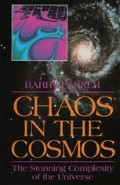Abstract
Earlier we saw that chaos arises in phenomena described by nonlinear equations. It occurs even in very simple equations such as the one that describes the pendulum. General relativity, one of the most famous theories, is formulated in terms of a nonlinear equation. This makes us wonder if some of the phenomena described by general relativity, namely black holes, objects orbiting black holes, and even the universe itself, can become chaotic under certain circumstances. This is not an easy question to answer. The problem is the equation itself, namely the equation of general relativity; it is so complex that the most general solution has never been obtained. It has, of course, been solved for many simple systems; if the system has considerable symmetry (e.g., it is spherical) the equation reduces to a number of ordinary equations that can be solved, but chaos does not occur in these cases. In more realistic cases—situations that actually occur in nature—chaos may occur, but the equations are either unsolvable or very difficult to solve. This presents a dilemma. If we try to model the system using many simplifications it won’t exhibit chaos, but if we model it realistically we can’t solve it.
Access this chapter
Tax calculation will be finalised at checkout
Purchases are for personal use only
Preview
Unable to display preview. Download preview PDF.
Bibliography
Barrow, John, “Chaos in Einstein’s Equations” Phys. Rev. Lett. 46, 15 (April 1981) 963.
Berger, Beverly, “Numerical Study of Initially Expanding Mixmaster Universes” Class Quantum Gravity 7 (1990) 203.
Bombelli, Luca, and Calzetta, Esteban, “Chaos around a Black Hole” Class Quantum Gravity 9 (1992) 2573.
Chandrasekhar, S., “The Two-Centre Problem in General Relativity: The Scattering of Radiation of Two Extreme R. N. Black Holes” Proc. R. Soc. London A 421 (1989) 227.
Contoupolos, G., “Periodic Orbits and Chaos around Two Black Holes” Proc. R. Soc. London A 431 (1990) 183.
Misner, Charles, “Mixmaster Universe” Phys. Rev. Lett. 22 (May 1969) 1071.
Rugh, Svend, “Chaos in the Einstein Equation: Characterization and Importance” Deterministic Chaos in General Relativity, D. Hobill (ed.) ( New York: Plenum, 1994 ).
Rights and permissions
Copyright information
© 1996 Barry Parker
About this chapter
Cite this chapter
Parker, B. (1996). Chaos in General Relativity, Black Holes, and Cosmology. In: Chaos in the Cosmos. Springer, Boston, MA. https://doi.org/10.1007/978-1-4899-3370-6_13
Download citation
DOI: https://doi.org/10.1007/978-1-4899-3370-6_13
Publisher Name: Springer, Boston, MA
Print ISBN: 978-0-306-45261-1
Online ISBN: 978-1-4899-3370-6
eBook Packages: Springer Book Archive

